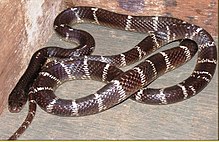Common krait
| Common krait | |
|---|---|

| |
| Scientific classification | |
| Domain: | Eukaryota |
| Kingdom: | Animalia |
| Phylum: | Chordata |
| Class: | Reptilia |
| Order: | Squamata |
| Suborder: | Serpentes |
| Family: | Elapidae |
| Genus: | Bungarus |
| Species: | B. caeruleus
|
| Binomial name | |
| Bungarus caeruleus (Schneider, 1801)
| |

| |
| Synonyms | |
|
Pseudoboa caerulea Schneider, 1801, Bungarus candidus var. Cærulus Boulenger, 1896 | |
The common krait (Bungarus caeruleus) is a highly venomous snake species belonging to the genus Bungarus in the Elapidae family. It is native to the Indian subcontinent and is responsible for the majority of snakebites affecting humans in India, Pakistan, and Bangladesh.
Description
[edit]
The average length of the common krait is 0.9 m (2 ft 11 in), but it can grow to 1.75 m (5 ft 9 in).[2] Males are longer than females, with proportionately longer tails. The head is flat and the neck is hardly visible. The body is cylindrical, tapering towards the tail. The tail is short and rounded. The eyes are rather small, with rounded pupils, indistinguishable in life. The head shields are normal, with no loreals; four shields occur along the margin of the lower lip; the third and fourth supraoculars touch the eye. The scales are highly polished, in 15–17 rows; the vertebral row is distinctly enlarged and hexagonal. Ventrals number 185–225 and caudals 37–50, and are entirely intact.[3] Their coloration is generally black or bluish-black, with about 40 thin, white crossbars, which may be indistinct or absent anteriorly. Albino specimens can be found, although such cases are extremely rare. The pattern, however, is complete and well-defined in the young, which are marked with conspicuous crossbars even anteriorly; in old individuals, the narrow white lines may be found as a series of connected spots, with a prominent spot on the vertebral region. A white preocular spot may be present; the upper lips and belly are white.[3]
Distribution and habitat
[edit]This common krait is distributed from West Bengal to Sindh, throughout South India, and Sri Lanka, at elevations up to about 1,600 m (5,200 ft).[2] It has also been recorded in Afghanistan, Pakistan, Iran, Bangladesh, and Nepal.[4] It lives in a wide variety of habitats, from fields and low scrub jungle to settled areas. It rests in termite mounds, brick piles, rat holes, and even inside houses.[2]
Behaviour and ecology
[edit]

The common krait exhibits a sluggish and generally docile behaviour during the day. It often hides in rodent holes, loose soil, or beneath debris, so is rarely seen. It often rolls its body into a loose, coiled ball, keeping its head well concealed. When in this "balled" condition, the snake allows considerable handling, but overhandling often instigates bites. At night, though, the snake is very active and escapes by hissing loudly, or keeping still, occasionally biting the source of the annoyance.

When agitated, it coils up with its head concealed and body flattened, and makes jerky movements. It may also lift its tail. It is reluctant to bite, but when it does, it typically holds on for a while, which enables it to inject considerable amounts of venom. It may become aggressive at night if threatened, since this is its active time. It is responsible for the second-highest number of snake bites in India for a single species. In Bangladesh, it is responsible for 28% of total snake bites.
Diet
[edit]The common krait feeds primarily on other snakes, and cannibalises on other kraits, including the young. It also feeds on small mammals such as rats, mice, lizards, and frogs. The young are known to eat arthropods and the blind snakes snakes of the family Typhlopidae.
Venom
[edit]In mice, the LD50 values of its venom are 0.325 mg/kg subcutaneously, 0.169 mg/kg intravenously, and 0.089 mg/kg intraperitoneally.[5][6] The average venom yield is 10 mg (0.15 gr) dry weight.[7] The estimated lethal dose for humans is 2–3 mg (0.031–0.046 gr).[8]
The common krait is nocturnal, so seldom encounters humans during daylight; incidents occur mainly at night. Frequently, little or no pain occurs from its bite, which can provide false reassurance to the victim. Typically, victims complain of severe abdominal cramps, accompanied by progressive paralysis. If death occurs, it takes place about 4–8 hours after the krait bite. Cause of death is general respiratory failure, i.e. suffocation.[9] The few symptoms of the bite include tightening of the facial muscles in 1–2 hours of the bite and inability of the bite victim to see or talk, and if left untreated, the patient may die from respiratory paralysis within 4–5 hours. A clinical toxicology study reports an untreated mortality rate of 70-80%.[2]
References
[edit]- ^ Mohapatra, P.; Giri, V.; Suraj, M.; Das, A.; Srinivasulu, C.; Kandambi, D.; Ukuwela, K. (2021). "Bungarus caeruleus". IUCN Red List of Threatened Species. 2021: e.T172702A1369896. doi:10.2305/IUCN.UK.2021-3.RLTS.T172702A1369896.en. Retrieved 15 August 2023.
- ^ a b c d "Clinical Toxinology-Bungarus caeruleus". Archived from the original on 2016-10-16. Retrieved 2011-11-10.
- ^ a b Gopalkrishnakone, P.; Chou, L.M. (1990). Snakes of Medical Importance: Asia-Pacific Region. Singapore: Venom and Toxin Research Group, National University of Singapore. pp. 284–28?. ISBN 9971-62-217-3.
- ^ Bungarus&species=caeruleus 'Bungarus caeruleus' at the Reptarium.cz Reptile Database. Accessed 18 November 2013.
- ^ "LD50". Archived from the original on 2012-02-01.
- ^ "LD50 menu". Archived from the original on 2012-04-13.
- ^ Engelmann, W.-E. (1981). Snakes: Biology, Behavior, and Relationship to Man. Leipzig; English version NY, USA: Leipzig Publishing; English version published by Exeter Books (1982). p. 51. ISBN 0-89673-110-3.
- ^ Ceylon Medical Journal. Ceylon Medical Association. 1983.
- ^ "Medical Management for bites by Kraits (Bungarus species)". Archived from the original on 2012-04-02.
Further reading
[edit]- Whitaker, R. (1978). Common Indian Snakes: A Field Guide. Macmillan India Limited.

